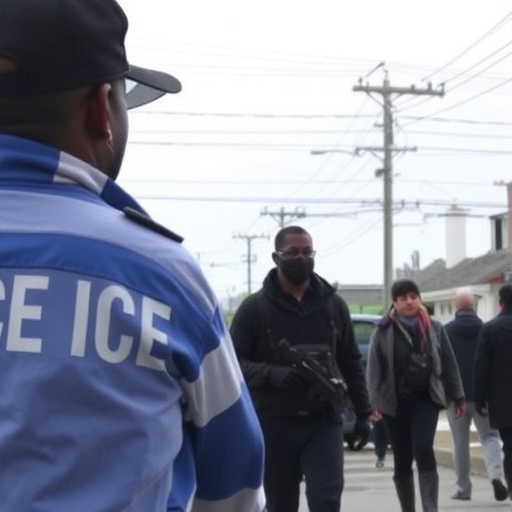Chicago South Shore ICE Raid Fallout: Housing Crisis, Migration Tensions, and Local Politics Explode in Debate
In the heart of Chicago‘s South Shore neighborhood, a dawn ICE raid on a blustery Tuesday morning shattered the fragile peace of a community already grappling with displacement and decay. Federal agents, clad in tactical gear, descended on a cluster of aging apartment buildings, detaining over 50 individuals suspected of immigration violations. The operation, which lasted mere hours, has unleashed a torrent of outrage, forcing Chicago‘s housing crisis, migration policies, and local politics into the national spotlight. Residents, many of whom have called this lakefront enclave home for generations, now fear not just for their neighbors but for the very fabric of their community.
The raid targeted undocumented migrants housed in substandard conditions, highlighting the intersection of federal enforcement and local neglect. Eyewitnesses described scenes of chaos: families torn apart, children screaming, and agents blocking streets as helicopters buzzed overhead. “It felt like an invasion,” said Maria Gonzalez, a 45-year-old South Shore resident who watched from her stoop. “These people are our neighbors, working hard despite everything. This isn’t justice; it’s cruelty.”
Chicago, a sanctuary city with a storied history of welcoming immigrants, finds itself at a crossroads. The ICE raid has amplified long-simmering tensions, with activists decrying it as a symptom of broader systemic failures in addressing the housing crisis and migration challenges. As protests swell and politicians scramble, the fallout promises to reshape local politics for years to come.
The Dawn Raid: Chaos in Chicago’s South Shore
The ICE raid unfolded just after 5 a.m. on October 15, 2023, in the 7100 block of South Jeffery Boulevard, a stretch lined with brick low-rises that have seen better days. According to a statement from U.S. Immigration and Customs Enforcement (ICE), the operation was part of a broader initiative targeting “public safety threats” in urban areas. Agents executed search warrants on three buildings, arresting 52 people—mostly men from Central America and Mexico—on charges ranging from overstayed visas to prior deportations.
But the numbers tell only part of the story. Community leaders report that the raid disrupted over 100 lives, including U.S. citizen children left behind in the scramble. The Chicago Police Department, bound by the city’s sanctuary policies, provided minimal support, leading to accusations of federal overreach. “We were told to stand down,” said an anonymous CPD officer. “This is ICE’s show, but it’s our streets they’re tearing up.”
Video footage, quickly shared on social media, captured the raid’s intensity: flashing lights piercing the pre-dawn fog, agents shouting in Spanish, and residents peering from windows in disbelief. By midday, the block was a hive of activity, with legal aid groups setting up impromptu clinics and faith leaders offering solace. The event’s virality—garnering over 500,000 views on TikTok alone—has turned South Shore into a symbol of resistance against aggressive immigration enforcement.
Historical context adds layers to the incident. South Shore, once a thriving Black middle-class haven in the mid-20th century, has faced decades of white flight, redlining, and economic decline. The arrival of migrants in recent years, fleeing violence in their homelands, has both revitalized and strained the neighborhood. The ICE raid, critics argue, exploits these vulnerabilities, preying on those least able to defend themselves.
Exposing the Housing Crisis: Dilapidated Dwellings and Displacement Fears
Beneath the raid’s drama lies Chicago’s entrenched housing crisis, a powder keg ignited by years of underinvestment and predatory development. The targeted buildings, owned by a private equity firm notorious for skimping on maintenance, epitomize the decay plaguing South Shore. Leaky roofs, mold-infested walls, and faulty wiring are commonplace, with rents soaring 30% in the last five years despite the squalor.
According to a 2023 report from the Chicago Housing Authority (CHA), over 40% of South Shore’s 25,000 residents live in substandard housing, far above the citywide average of 22%. Vacancy rates hover at 15%, fueling speculation that landlords use immigration status as a cudgel to evict tenants and flip properties. “These raids aren’t random,” explained housing advocate Jamal Rivera of the South Side Community Council. “They’re a tool for displacement. ICE sweeps in, scares everyone out, and developers swoop in for the land.”
Statistics paint a grim picture: Since 2010, South Shore has lost 2,500 affordable housing units to demolition or conversion, displacing thousands. Migrant families, often paying under-the-table rents, are particularly vulnerable. A study by the Urban Institute found that 60% of undocumented households in Chicago face eviction threats annually, exacerbated by the lack of legal protections.
Resident testimonies underscore the human toll. “My building’s been without heat for weeks,” shared Elena Vasquez, a single mother whose brother was detained in the raid. “We complain, but the landlord says, ‘Pay or leave.’ Now, with ICE involved, who’s going to stay?” Protests following the raid have included rent strikes, with over 200 tenants withholding payments to demand repairs and transparency from property owners.
The housing crisis ties directly into broader migration patterns. Chicago’s Venezuelan influx—over 20,000 arrivals since 2022—has overwhelmed shelters, pushing many into informal arrangements like those in South Shore. City officials, strained by a $1.2 billion budget shortfall, have allocated only $150 million for migrant housing this year, leaving gaps that federal actions like the ICE raid exploit.
Migration Policies Under Scrutiny: From Sanctuary City to Federal Flashpoint
Chicago’s status as a sanctuary city, formalized in 1985 and strengthened under Mayor Lori Lightfoot, was meant to shield migrants from deportation fears. Yet the South Shore ICE raid exposes cracks in this shield. Federal agents bypassed local protocols by operating pre-dawn and without prior notification, a tactic decried by immigration rights groups like the National Immigrant Justice Center.
“This raid violates the spirit of our sanctuary laws,” stated attorney Sofia Ramirez during a press conference outside City Hall. “ICE is using housing violations as a pretext to hunt migrants, turning neighborhoods into war zones.” Data from the center shows a 25% uptick in ICE activities in sanctuary cities since 2021, correlating with rising border crossings—over 2.4 million encounters nationwide last fiscal year.
Migration debates have intensified locally. South Shore’s diverse fabric—45% Black, 30% Latino, 15% white—fosters solidarity but also strains. Some residents express frustration over resource competition, with a recent poll by the Chicago Tribune revealing 35% of South Siders viewing recent migrants as a “burden” on services. Activists counter that anti-migrant sentiment is manufactured, pointing to shared struggles against poverty and gentrification.
Quotes from those affected resonate deeply. “I came from Honduras to escape gangs, not to hide in crumbling apartments,” said detained worker Carlos Mendoza, released on bond and speaking at a rally. “Chicago welcomed me once; now it feels like betrayal.” Community responses include mutual aid networks, with groups like Arise Chicago distributing $50,000 in emergency funds post-raid.
On the policy front, calls for reform grow louder. Governor J.B. Pritzker has urged federal restraint, while local NGOs push for expanded work permits and housing vouchers for migrants. The raid’s timing, amid stalled congressional immigration bills, underscores the urgency: Without comprehensive reform, incidents like this will recur, deepening divides.
Local Politics Ignites: Aldermen, Activists, and the Battle for South Shore’s Future
The ICE raid has thrust local politics into overdrive, with Chicago’s 7th Ward—encompassing South Shore—becoming a battleground. Alderman Gregory Mitchell, a vocal critic of federal immigration tactics, hosted a town hall that drew 500 attendees, where chants of “No raids in our city!” echoed through the halls.
“This is about power—who controls our communities,” Mitchell told reporters. “The housing crisis isn’t accidental; it’s policy failure from City Hall to Washington.” His stance contrasts with more conservative voices on the City Council, where four aldermen have called for reviewing sanctuary status amid rising crime rates—up 12% in South Shore last year, per CPD stats.
Political ramifications extend to the 2024 mayoral race. Progressive candidates like Cook County Commissioner Brandon Johnson decry the raid as emblematic of Mayor Brandon Johnson’s uneven migrant response, despite his $300 million aid package. “We need bold action, not Band-Aids,” Johnson said in a debate, linking housing and migration to economic justice.
Activists are mobilizing: The South Shore Justice Coalition, formed post-raid, has collected 10,000 signatures for a ballot initiative mandating affordable housing quotas in redevelopment projects. Partnerships with national groups like the ACLU aim to sue ICE for civil rights violations, potentially setting precedents.
Yet challenges persist. Budget constraints limit interventions; Chicago’s property tax hikes—8% in 2023—have squeezed low-income voters, influencing electoral dynamics. As one political analyst noted, “Local politics here is migration politics now—it’s reshaping alliances and voter turnout.”
Looking ahead, the raid’s legacy could catalyze change. Community-led audits of housing stocks are underway, with demands for $500 million in state funds for South Shore revitalization. Federal lawsuits may curb ICE tactics, while grassroots efforts build resilience. If history is a guide—from the 1968 riots to the 2017 sanctuary marches—Chicago’s South Shore will not fade quietly. The debates over housing, migration, and local politics are just beginning, promising a fiercer fight for equity in the Windy City.









